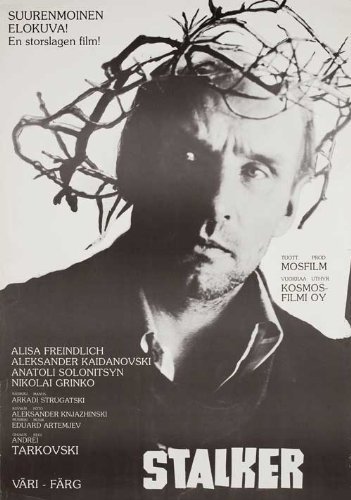Previous FilmSpaceways
Next FilmStar Odyssey
Stalke 1979
 | A guide leads two men through an area known as the Zone to find a room that grants wishes. |
The Cast
| Alisa Freyndlikh | - | Zhena Stalkera |
| Aleksandr Kaydanovskiy | - | Stalker |
| Anatoliy Solonitsyn | - | Pisatel |
| Nikolay Grinko | - | Professor |
| Natalya Abramova | - | Marta, doch Stalkera |
| Faime Jurno | - | Sobesednitsa Pisatelya |
| E. Kostin | - | Lyuger, khozyain kafe |
| Raymo Rendi | - | Patrulnyy politseyskiy |
Film Trivia
According to the film's sound designer Vladimir Sharun, at least 3 members of the production, including actor Anatoliy Solonitsyn, director Andrei Tarkovsky and his wife/assistant director Larisa Tarkovskaya, died from cancer as a result of chemical contamination encountered on location in Estonia.
The Zone of the film was inspired by a nuclear accident that took place near Chelyabinsk in 1957. Several hundred square kilometers were polluted by fallout and abandoned. There was no official mention of this "forbidden zone" at the time.
This film averages a new camera shot every 88 seconds.
The film was initially shot on Kodak 5247 stock. This film stock was newer to Soviet laboratories of the time, and some of the original negatives were destroyed by a processing error at the laboratory. Part of the film had to be shot again with a new cinematographer, Aleksandr Knyazhinskiy. This contributed to the film's two-part narrative structure. Allegedly, the newly shot footage strayed farther away from the source novel Roadside Picnic, and had a different look. Asked about this, director Andrei Tarkovsky said "no mother gives birth to the same child twice".
It is said that the rushes of the first version of the film were kept by editor Lyudmila Feyginova in her home for years. They were destroyed by a fire that also claimed her life.
To allow changes to the color tone of a long strip of film over an extended take, director Andrei Tarkovsky built a long film processing vat which had different temperatures along the way.
The poetry of Arseny Tarkovsky (father of director Andrei Tarkovsky) inspires much of this film.
When the Stalker is referred to as 'Chingachgook' and 'Leatherstocking,' these are references to characters in James Fenimore Cooper's novel "The Last of the Mohicans."
This film inspired video game developer GSC Game World to create STALKER:Shadow of Chernobyl. The game puts players into the role of a stalker who must navigate The Zone looking for answers to his amnesia.
There is no dialogue for the first 9.5 minutes.
Towards the end of the movie, the Stalker's wife smokes cigarettes from a carton that bears the same AT (Andrei Tarkovsky) insignia as the policeman's helmet.
"The 'ascetic' plot of Stalker was a central part of a conscious strategy to focus attention almost wholly on the image itself, and avoid "entertaining or surprising the spectator" (Director Andrei Tarkovsky - Element of Cinema by Robert Bird © 2008). In a 1981 interview, Tarkovsky further stated that "those who are looking for meaning while viewing will miss everything. My ideal viewer watches a movie like a traveler observes the country he is visiting".
The insignia on the police officers' helmet features two letters: AT, the initials of the director, Andrei Tarkovsky.
The on-screen Russian title (in Cyrillic alphabet) is a transliteration of the English word Stalker.
Tarkovsky wanted to abandon further work on the film multiple times.
Many movie experts and fans have theorized that the movie is based on The Wizard of Oz (1939), since both switch from sepia tones to full color as soon as the mythical place (Oz and the Zone) is reached. Both films also feature a destination where wishes may be granted. Director Andrei Tarkovsky has never spoken out about these similarities. About the nature of the Zone, he said in 1979 that "the viewer may doubt the existence of the Zone, regard it as myth or a joke... or even as something made up by our hero".
For the central part of the film, in which the characters travel within the Zone, director Andrei Tarkovsky initially wanted to shoot in the environment around an old Chinese mine. However, when the mine was destroyed by an earthquake shortly before filming, the production moved to two deserted hydro power plants on the Jägala river near Tallinn, Estonia.
Loosely based on the novel 'Piknik na obochine' (Roadside Picnic) by Russian writers (and brothers) Arkadiy Strugatskiy and Boris Strugatskiy. Although the novelists also received credit for the screenplay, the book was actually adapted by director Andrei Tarkovsky, who remained uncredited for the script. Tarkovsky himself claimed that the words "Stalker" and "Zone" were the only two things the book and film had in common.
The film contains 142 shots in 163 minutes, with an average shot length of more than one minute and many shots lasting for more than four minutes.
Officials at Goskino, a government group otherwise known as the State Committee for Cinematography, were critical of the film. Of their criticism Tarkovsky supposedly retorted: "I am only interested in the views of two people: one is called Bresson and one called Bergman."
Included among the "1001 Movies You Must See Before You Die", edited by Steven Schneider.
Ranked number 49 non-English-speaking film in the critics' poll conducted by the BBC in 2018.
The scenes of the girl moving the glasses on the table with her mind at the end of the film were honored in the music video for the song "Bedtime Story" from Madonna.